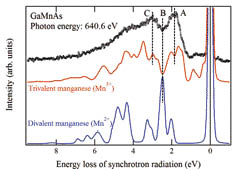Clarification of Mechanism of Ferromagnetism in Ferromagnetic Semiconductor
M. Kobayashi, A. Tanaka, and Y. Harada
A ferromagnetic semiconductor (FMS), in which a host semiconductor is doped with a low concentration of magnetic ions, has attracted much attention in spintronics, which exploits the properties of magnets for electronics indispensable in industry. These semiconductors have both electrical properties of a semiconductor and magnetic properties of a doped magnetic element. Ga1-xMnxAs (GaMnAs) is a typical ferromagnetic semiconductor obtained by doping a small amount of manganese (Mn) into gallium arsenide (GaAs). Its practical application as a spintronics material is being examined because it exhibits ferromagnetism at a relatively high temperature. However, the mechanism of ferromagnetism in GaMnAs has not been conclusively determined, and various physical models have been proposed.

Fig. 1. Soft X-ray emission spectrum of GaMnAs and simulation results. The simulation result for Mn3+ (red) is in good agreement with the experimental spectrum (black).

Fig. 2. Models for mechanism of ferromagnetism in Ga1-xMnxAs: (a) Zener's p-d exchange model and (b) magnetic polaron model. The direction of the arrows in the upper figure indicates the direction of magnets.
In this study, to address the electronic structure of the doped Mn ions, we report the results of Mn L3 x-ray absorption spectroscopy (XAS) and resonant inelastic x-ray scattering (RIXS) measurements of Ga1−xMnxAs (x = 0.04) at SPring-8 BL23SU and BL07LSU [1], respectively. RIXS is a powerful tool to investigate electronic excitations in element- and symmetry-specific ways including d-d and charge-transfer (CT) excitations for open shell 3d orbitals [2], and magnetic excitations for spin or charge-ordered systems [3]. These excitations are sensitive to electron correlation, crystalline symmetry, and the strength of hybridization with the ligand band. The RIXS spectra obtained for Ga1−xMnxAs are compared with configuration-interaction (CI) cluster-model calculations [4], and the electronic structure parameters are estimated.
The obtained XAS spectrum was compared with the CI cluster model calculations. Both the calculated spectra for the Mn2+ and Mn3+ states well reproduce the experimental XAS spectrum and we cannot determine the effective charge on the Mn site. On the other hand, the RIXS spectra provide definitive information: the RIXS spectra in Fig. 1 show a broad profile even at energy resolutions high enough to distinguish individual d-d excitation peaks of MnO. An analysis by the CI calculations indicates that the Mn ground states mainly consist of the Mn3+ electronic configuration composed of the charge-transferred states (d5L and d6L2), in which the ligand hole is weakly bound to the Mn 3d5 state (which can be explained by the magnetic polaron model: Fig. 2(b)), rather than the pure Mn2+ state (which can be explained by the Zener’s p-d exchange model: Fig. 2(a)). In order to reproduce the experimental broadening of the Mn d-d excitation, not only the (Gaussian) broadening by the energy resolution but also the 0.5 eV Lorentzian broadening is required. The additional Lorentzian broadening in the RIXS spectra can be attributed to the lifetime broadening in the final state of the RIXS process where fast decay of the d-d excitations to an electron-hole pair in the host valence and conduction bands occurs because of the hybridization between the Mn 3d orbital and the ligand band.
References
- [1] G. Ghiringhelli, M. Matsubara, C. Dallera, F. Fracassi, A. Tagliaferri, N. B. Brookes, A. Kotani, and L. Braicovich, Phys. Rev. B 73, 035111 (2006).
- [2] M. L. Tacon, G. Ghiringhelli, J. Chaloupka, M. M. Sala, V. Hinkov, M. W. Haverkort, M. Minola, M. Bakr, K. J. Zhou, S. Blanco-Canosa, C. Monney, Y. T. Song, G. L. Sun, C. T. Lin, G. M. D. Luca, M. Salluzzo, G. Khaliullin, T. Schmitt, L. Braicovich, and B. Keimer, Nat. Phys. 7, 725 (2011).
- [3] A. Tanaka and T. Jo, J. Phys. Soc. Jpn. 63, 2788 (1994).
